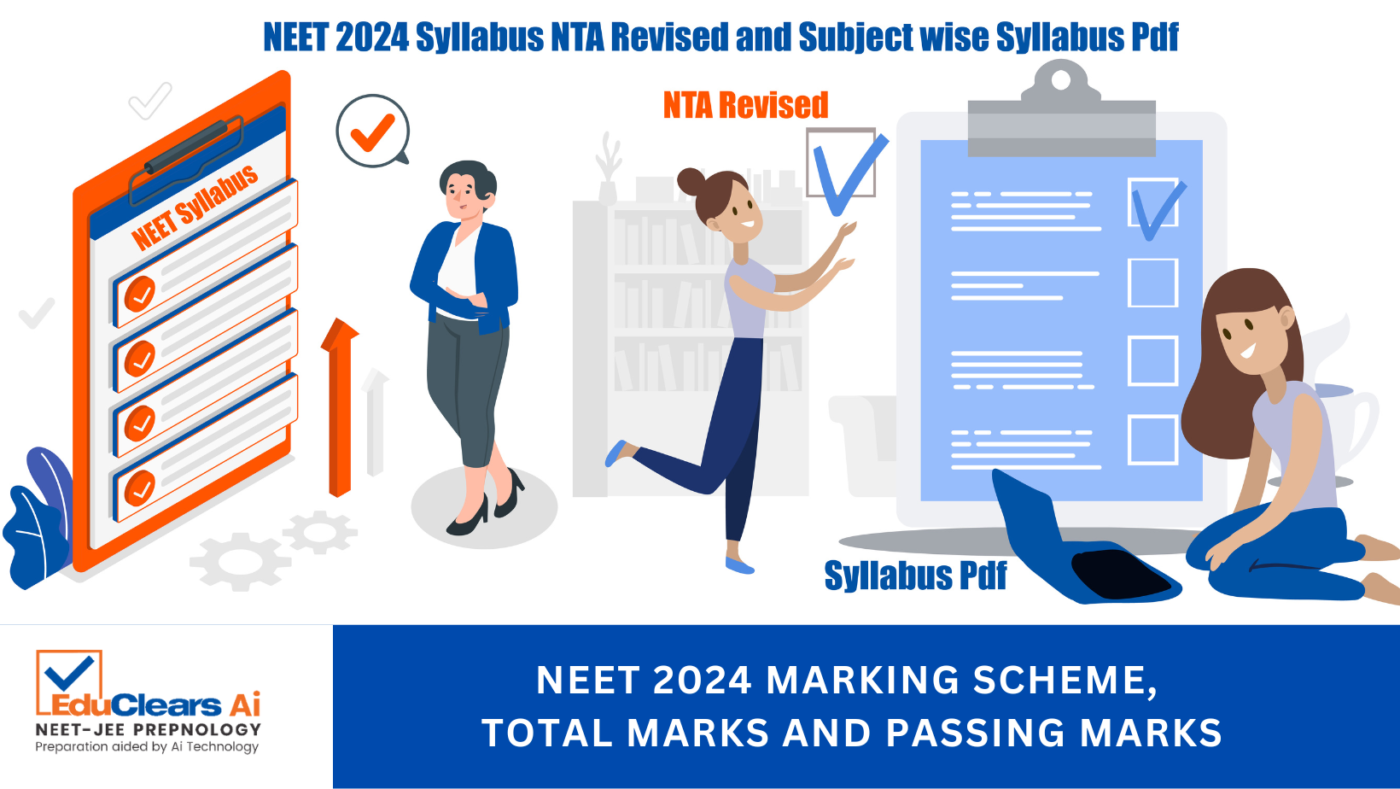What is the NEET 2024 syllabus is a crucial topic for students who are preparing for NEET 2024. The National Entrance cum Eligibility Test, or NEET, is administered in India to applicants seeking admission to undergraduate medical programmes. Students who have finished Class 12th or its equivalent take this all-India test. Beginning with the 2013–14 academic years, NEET took the place of the All India Pre-Medical Test (AIPMT).
The date of the NEET 2024 exam is set for May 5; 2024. Acquiring accurate curriculum information is the first step towards preparing for NEET 2024. Prior to anything else, students should fully comprehend the syllabus. A solid comprehension of the syllabus could aid a student in creating an efficient study strategy. Understanding the NCERT curriculum in-depth can help you prepare better for the NEET 2024 exam, as it forms the basis of the exam.
The NEET 2024 syllabus has seen significant alterations. The NEET 2024 syllabus can be downloaded in PDF format right now. On November 22, NTA made it available on the exam conducting body’s official website. The National Medical Commission (NMC) previously released a syllabus that is identical to the NTA NEET 2024 syllabus. Thus, it may be concluded that the NMC and NTA NEET syllabuses are the same.
The updated NEET 2024 syllabus for Physics, Chemistry, and Biology has several chapters and topics deleted. However, some chapters have been added, and some topics have been changed. The three subjects that make up the NEET 2024 syllabus are physics, chemistry, and biology (Botany and Zoology). The NEET 2024 syllabus will contain topics from Class 11 and Class 12 that are covered in these three subjects.
In this blog we will share the NTA revised NEET 2024 syllabus.
Before moving into that part let’s check some important dates of NEET 2024
NEET 2024 IMPORTANT DATES AND EVENTS
| NEET 2024 IMPORTANT EVENTS | DATES |
| APPLICATION FORM AVAILABLE | March 2024 |
| FINAL DATE TO SUBMIT THE APPLICATION FORM | April 2024 |
| FEE SUBMIT ON THE LAST DATE | April 2024 |
| APPLICATION FORM CORRECTION | April 2024 |
| NEET 2024 ADMIT CARD | 4th week of April 2024 |
| NEET 2024 EXAM DATE | 5th May 2024 |
| RESULT DECLARATION | 1st week of June 2024 |
| BEGINNING OF THE COUNSELING | 2nd week of June 2024 |
NEET 2024 SYLLABUS REVISED (SUBJECT WISE)
PHYSICS DELETED TOPICS IN NEET 2024 SYLLABUS
| PHYSICS AND MEASUREMENT | SCOPE AND EXCITEMENT; NATURE OF PHYSICAL LAWS; PHYSICS, TECHNOLOGY, AND SOCIETY NEED FOR MEASUREMENT: LENGTH, MASS, AND TIME MEASUREMENTS, ACCURACY AND PRECISION OF MEASURING INSTRUMENTS |
| KINEMATICS | ELEMENTARY CONCEPTS OF DIFFERENTIATION AND INTEGRATION FOR DESCRIBING MOTION, SCALAR AND VECTOR QUANTITIES: POSITION AND DISPLACEMENT VECTORS, GENERAL VECTORS, GENERAL VECTORS AND NOTATION, EQUALITY OF VECTORS, MULTIPLICATION OF VECTORS BY A REAL NUMBER |
| LAWS OF MOTION | EQUILIBRIUM OF CONCURRENT FORCES, LUBRICATION |
| ROTATIONAL MOTION | MOMENTUM CONSERVATION, CENTRE OF MASS OF UNIFORM ROD |
| GRAVITATION | GEOSTATIONARY SATELLITES |
| PROPERTIES OF SOLIDS AND LIQUIDS | SHEAR, MODULUS OF RIGIDITY, POISSON’S RATIO; ELASTIC ENERGY, REYNOLD’S NUMBER, QUALITATIVE IDEAS OF BLACK BODY RADIATION, WEIN’S DISPLACEMENT LAW, AND GREEN HOUSE EFFECT, CP, CV, NEWTON’S LAW OF COOLING AND STEFAN’S LAW |
| THERMODYNAMICS | HEAT ENGINES AND REFRIGERATORS |
| OSCILLATIONS AND WAVES | FREE, FORCED AND DAMPED OSCILLATIONS (QUALITATIVE IDEAS ONLY), RESONANCE, DOPPLER EFFECT |
| ELECTROSTATICS | FREE CHARGES AND BOUND CHARGES INSIDE A CONDUCTOR, VAN DE GRAAFF GENERATOR |
| CURRENT ELECTRICITY | THE FLOW OF ELECTRIC CHARGES IN A METALLIC CONDUCTOR, CARBON RESISTORS, COLOR CODE FOR CARBON RESISTORS, POTENTIOMETER-PRINCIPLE AND APPLICATIONS TO MEASURE POTENTIAL DIFFERENCE, AND FOR COMPARING EMF OF TWO CELLS; MEASUREMENT OF INTERNAL RESISTANCE OF A CELL |
| MAGNETIC EFFECTS OF CURRENT AND MAGNETISM | CONCEPT OF MAGNETIC FIELD, OERSTED’S EXPERIMENT, CYCLOTRON, MAGNETIC DIPOLE MOMENT OF A REVOLVING ELECTRON, EARTH’S MAGNETIC FIELD AND MAGNETIC ELEMENTS, PERMANENT MAGNETS |
| ELECTROMAGNETIC INDUCTION AND ALTERNATING CURRENT | LC OSCILLATIONS (QUALITATIVE TREATMENT ONLY) |
| OPTICS | REFLECTION AND REFRACTION OF PLANE WAVE AT A PLANE SURFACE USING WAVEFRONTS, SCATTERING OF LIGHT BLUE COLOUR OF THE SKY AND REDDISH APPEARANCE OF THE SUN AT SUNRISE AND SUNSET, OPTICAL INSTRUMENTS: HUMAN EYE, IMAGE FORMATION, AND ACCOMMODATION, CORRECTION OF EYE DEFECTS (MYOPIA AND HYPERMETROPIA) USING LENSES, MICROSCOPES AND ASTRONOMICAL TELESCOPES (REFLECTING AND REFRACTING) AND THEIR MAGNIFYING POWERS. |
| DUAL NATURE OF MATTER AND RADIATION | DAVISSON-GERMER EXPERIMENT (EXPERIMENTAL DETAILS SHOULD BE OMITTED; ONLY CONCLUSION SHOULD BE EXPLAINED) |
| ATOMS AND NUCLEI | ISOTOPES, ISOBARS; ISOTONES, RADIOACTIVITY- ALPHA, BETA, AND GAMMA PARTICLES/ RAYS AND THEIR PROPERTIES DECAY LAW |
| ELECTRONIC DEVICES | ENERGY BANDS IN SOLIDS (QUALITATIVE IDEAS ONLY), CONDUCTORS, INSULATORS, JUNCTION TRANSISTOR, TRANSISTOR ACTION, CHARACTERISTICS OF A TRANSISTOR; TRANSISTOR AS AN AMPLIFIER (COMMON EMITTER CONFIGURATION) AND OSCILLATOR, TRANSISTOR AS A SWITCH |
PHYSICS ADDED TOPICS IN NEET 2024 SYLLABUS
GRAVITATION
Motion of a satellite, time period, and energy of a satellite
PROPERTIES OF SOLIDS AND LIQUIDS
Pressure due to a fluid column; Pascal’s law and its applications. Effect of gravity on fluid pressure
KINETICS THEORY OF GASES
RMS speed of gas molecules, Avogadro’s number
MAGNETIC EFFECTS OF CURRENT AND MAGNETISM
Effect of Temperature on Magnetic Properties
DUAL NATURE OF MATTER AND RADIATION
Dual nature of radiation
EXPERIMENTAL SKILLS
Familiarity with the basic approach and observations of the experiments and activities
1. Vernier calipers are used to measure the internal and external diameter and depth of a vessel.
2. Screw gauge-its used to determine the thickness diameter of thin sheet/wire.
3. Simple pendulum-dissipation of energy by plotting a graph between the square of amplitude and time.
4. Metre Scale – the mass of a given object by the principle of moments.
5. Young’s modulus of elasticity of the material of a metallic wire.
6. Surface tension of water by capillary rise and effect of detergents.
7. Co-efficient of Viscosity of a given viscous liquid by measuring the terminal velocity of a given spherical body.
8. Speed of sound in air at room temperature using a resonance tube.
9. Specific heat capacity of a given (i) solid and (ii) liquid by method of mixtures.
10. The resistivity of the material of a given wire using a meter bridge.
11. The resistance of a given wire using Ohm’s law.
12. Resistance and figure of merit of a galvanometer by half deflection method.
13. The focal length of; a. convex mirror b. Concave mirror, and c. convex lens, using the parallax method.
14. The plot of the angle of deviation vs angle of incidence for a triangular prism.
15. Refractive index of a glass slab using a travelling microscope.
16. Characteristic curves of a p-n junction diode in forward and reverse bias.
17. Characteristic curves of a Zener diode and finding reverse breakdown voltage.
18. Identification of Diode. LED,. Resistor. A capacitor from a mixed collection of such
CHEMISTRY DELETED TOPICS IN NEET 2024 SYLLABUS
| SOME BASIC CONCEPTS OF CHEMISTRY | GENERAL INTRODUCTION: IMPORTANT AND SCOPE OF CHEMISTRY |
| ATOMIC STRUCTURE | ATOMIC NUMBER, ISOTOPES AND ISOBARS. CONCEPT OF SHELLS AND SUBSHELLS, DUAL NATURE OF LIGHT |
| CHEMICAL THERMODYNAMICS | THIRD LAW OF THERMODYNAMICS- BRIEF INTRODUCTION |
| SOME P-BLOCK ELEMENTS | ATOMIC NUMBER, ISOTOPES, AND ISOBARS, CONCEPT OF SHELLS AND SUBSHELLS, DUAL NATURE OF MATTER AND LIGHT |
| ORGANIC COMPOUNDS CONTAINING NITROGEN | CYANIDES AND ISOCYANIDES- WILL BE MENTIONED AT RELEVANT PLACES |
| ENVIRONMENTAL CHEMISTRY | ENVIRONMENTAL POLLUTION: AIR, WATER, AND SOIL POLLUTION, CHEMICAL REACTIONS IN THE ATMOSPHERE, SMOGS, MAJOR ATMOSPHERIC POLLUTANTS; ACID RAIN OZONE AND ITS REACTIONS, EFFECTS OF DEPLETION OF OZONE LAYER, GREENHOUSE EFFECT AND GLOBAL WARMING-POLLUTION DUE TO INDUSTRIAL WASTES; GREEN CHEMISTRY AS AN ALTERNATIVE TOOL FOR REDUCING POLLUTION, STRATEGY FOR CONTROL OF ENVIRONMENTAL POLLUTION. |
| POLYMERS | CLASSIFICATION- NATURAL AND SYNTHETIC, METHODS OF POLYMERIZATION (ADDITION AND CONDENSATION), COPOLYMERIZATION. SOME IMPORTANT POLYMERS: ARE NATURAL AND SYNTHETIC LIKE POLYESTERS, BAKELITE; RUBBER, AND BIODEGRADABLE, AND NON-BIODEGRADABLE POLYMERS. |
| CHEMISTRY IN EVERYDAY LIFE | 1. CHEMICALS IN MEDICINES- ANALGESICS, TRANQUILLISERS, ANTISEPTICS, DISINFECTANTS, ANTIMICROBIALS, ANTIFERTILITY DRUGS, ANTIBIOTICS, ANTACIDS, ANTIHISTAMINES. 2. CHEMICALS IN FOOD- PRESERVATIVES, ARTIFICIAL SWEETENING AGENTS, ELEMENTARY IDEAS OF ANTIOXIDANTS. 3. CLEANSING AGENTS- SOAPS AND DETERGENTS, CLEANSING ACTION |
CHEMISTRY ADDED TOPICS IN NEET 2024 SYLLABUS
ATOMIC STRUCTURE
Nature of electromagnetic radiation, photoelectric effect; Spectrum of the hydrogen atom. Bohr model of a hydrogen atom – its postulates, derivation of the relations for the energy of the electron and radii of the different orbits, limitations of Bohr’s model
CHEMICAL BONDING AND MOLECULAR STRUCTURE
Kossel – Lewis approach to chemical bond formation, the concept of ionic and covalent bonds, Elementary idea of metallic bonding, Fajan’s rule
CHEMICAL THERMODYNAMICS
Fundamentals of thermodynamics: System and surroundings, extensive and intensiveØ properties’ state functions, types of processes
REDOX REACTIONS AND ELECTROCHEMISTRY
Electrolytic and metallic conduction, conductance and their in electrolytic solutions, molar conductivities variation with concentration: Kohlrausch’s law and its applications
Electrochemical cells – Electrolytic and Galvanic cells, different types of electrodes, electrode potentials including standard electrode potential, half-cell and cell reactions, emf of a Galvanic Cell and its measurement: Nernst equation and its applications, Relationship between cell potential and Gibbs’ energy change: Dry cell and lead accumulator, Fuel cells
CHEMICAL KINETICS
Pressure, collision theory of bimolecular gaseous reactions (no derivation)
D AND F BLOCK ELEMENTS
Transition Elements
PURIFICATION AND CHARACTERIZATION OF ORGANIC COMPOUNDS
Purification – Crystallisation. sublimation, distillation, differential extraction, chromatography – principles and their applications
Qualitative analysis – Detection of nitrogen, sulphur, phosphorus and halogens
Quantitative analysis (basic principles only) – Estimation of carbon. hydrogen. nitrogen.halogens. sulphur. phosphorus.
Calculations of empirical formula and molecular formulae: Numerical problems in organic quantitative analysis
HYDROCARBONS
Classification of isomerism. IUPAC nomenclature, general methods of preparation, properties, and reactions
ORGANIC COMPOUNDS CONTAINING HALOGENS
General methods of preparation, properties, and reactions; Nature of C-X bond: Mechanisms of substitution reactions
Uses; Environmental effects of chloroform, iodoform freons, and DDTØ
PRINCIPLES RELATED TO PRACTICAL CHEMISTRY
Detection of extra elements (Nitrogen, sulphur, halogens), in organic compounds; Detection ofØ the following functional group, hydroxyl (alcoholic and phenolic), carbonyl (aldehyde and ketones) carboxyl, and amino groups in organic compounds.
The chemistry involved in the preparation of the following:
Inorganic compounds: Mohr’s salt. potash alum Organic compounds: Acetanilide. p-nitro acetanilide, aniline yellow, iodoform
The chemistry involved in the titrimetric exercises – Acids. Bases and the use of indicators. oxalic-acidvs KMnO4. Mohr’s salt vs KMnO4
Chemical principles involved in the qualitative salt analysis
Cations
Anions
Chemical principles involved in the following experiments:
1. Enthalpy of solution of CuSO4
2. Enthalpy of neutralization of strong acid and strong base
3. Preparation of lyophilic and lyophobic sols
4. Kinetic study of the reaction of iodide ions with hydrogen peroxide at room temperature.
BIOLOGY DELETED TOPICS IN NEET 2024 SYLLABUS
| DIVERSITY IN LIVING WORLD | THREE DOMAINS OF LIFE, TOOLS FOR STUDY OF TAXONOMY – MUSEUMS, ZOOS, HERBARIA, BOTANICAL GARDENS, ANGIOSPERMS, ANGIOSPERMS CLASSIFICATION UP TO CLASS, CHARACTERISTIC FEATURES AND EXAMPLES |
| STRUCTURAL ORGANIZATION IN ANIMALS AND PLANTS | MORPHOLOGY, ANATOMY AND FUNCTIONS OF DIFFERENT SYSTEMS (DIGESTIVE, CIRCULATORY, RESPIRATORY, NERVOUS AND REPRODUCTIVE) OF AN INSECT (COCKROACH). (BRIEF ACCOUNT ONLY) |
| PLANT PHYSIOLOGY | 1. TRANSPORT IN PLANTS: MOVEMENT OF WATER, GASES AND NUTRIENTS; CELL TO CELL TRANSPORT-DIFFUSION, FACILITATED DIFFUSION, ACTIVE TRANSPORT; PLANT – WATER RELATIONS – IMBIBITION, WATER POTENTIAL, OSMOSIS, PLASMOLYSIS; LONG DISTANCE TRANSPORT OF WATER – ABSORPTION, APOPLAST, SYMPLAST, TRANSPIRATION PULL, ROOT PRESSURE AND GUTTATION; TRANSPIRATION-OPENING AND CLOSING OF STOMATA; UPTAKE AND TRANSLOCATION OF MINERAL NUTRIENTS-TRANSPORT OF FOOD, PHLOEM TRANSPORT, MASS FLOW HYPOTHESIS; DIFFUSION OF GASES (BRIEF MENTION) 2.MINERAL NUTRITION: ESSENTIAL MINERALS, MACRO, AND MICRONUTRIENTS AND THEIR ROLE; DEFICIENCY SYMPTOMS; MINERAL TOXICITY; ELEMENTARY IDEA OF HYDROPONICS AS A METHOD TO STUDY MINERAL NUTRITION; NITROGEN METABOLISM-NITROGEN CYCLE, BIOLOGICAL NITROGEN FIXATION 3. SEED DORMANCY; VERNALISATION; PHOTOPERIODISM |
| HUMAN PHYSIOLOGY | 1. DIGESTION AND ABSORPTION; ALIMENTARY CANAL AND DIGESTIVE GLANDS; ROLE OF DIGESTIVE ENZYMES AND GASTROINTESTINAL HORMONES; PERISTALSIS, DIGESTION, ABSORPTION AND ASSIMILATION OF PROTEINS, CARBOHYDRATES AND FATS; CALORIC VALUE OF PROTEINS, CARBOHYDRATES AND FATS; EGESTION; NUTRITIONAL AND DIGESTIVE DISORDERS – PEM, INDIGESTION, CONSTIPATION, VOMITING, JAUNDICE, DIARRHEA 2. REFLEX ACTION; SENSE ORGANS; ELEMENTARY STRUCTURE AND FUNCTION OF EYE AND EAR |
| REPRODUCTION | REPRODUCTION IN ORGANISMS: REPRODUCTION, A CHARACTERISTIC FEATURE OF ALL ORGANISMS FOR CONTINUATION OF SPECIES; MODES OF REPRODUCTION – ASEXUAL AND SEXUAL; ASEXUAL REPRODUCTION; MODES-BINARY FISSION, SPORULATION, BUDDING, GEMMULE, FRAGMENTATION; VEGETATIVE PROPAGATION IN PLANTS |
| BIOLOGY AND HUMAN WELFARE | TOBACCO ABUSE, IMPROVEMENT IN FOOD PRODUCTION; PLANT BREEDING, TISSUE CULTURE, SINGLE CELL PROTEIN, BIOFORTIFICATION; APICULTURE AND ANIMAL HUSBANDRY |
| ECOLOGY AND ENVIRONMENT | 1. HABITAT AND NICHE, POPULATION AND ECOLOGICAL ADAPTATIONS, NUTRIENT CYCLING (CARBON AND PHOSPHOROUS); ECOLOGICAL SUCCESSION; ECOLOGICAL SERVICES- CARBON FIXATION, POLLINATION, OXYGEN RELEASE 2. ENVIRONMENTAL ISSUES: AIR POLLUTION AND ITS CONTROL; WATER POLLUTION AND ITS CONTROL; AGROCHEMICALS AND THEIR EFFECTS; SOLID WASTE MANAGEMENT; RADIOACTIVE WASTE MANAGEMENT; GREENHOUSE EFFECT AND GLOBAL WARNING; OZONE DEPLETION; DEFORESTATION; ANY THREE CASE STUDIES AS SUCCESS STORIES ADDRESSING ENVIRONMENTAL ISSUES. |
BIOLOGY ADDED TOPICS IN NEET 2024 SYLLABUS
STRUCTURAL ORGANIZATION IN ANIMALS AND PLANTS
Family (malvaceae, Cruciferae, leguminoceae, compositae, graminae)
Morphology, anatomy, and functions of different systems (digestive, circulatory, respiratory, nervous, and reproductive) of an insect (frog). (Brief account only)
CELL STRUCTURE AND FUNCTION
Classification and nomenclature of enzymes
GENETICS AND EVOLUTION
Protein biosynthesis
BIOLOGY AND HUMAN WELFARE
Dengue, Chikungunya
These were the topics for the NEET 2024 syllabus. We tried to mention all deleted and added chapters.
To download the PDF of NEET 2024 SYLLABUS click here.
Always be updated with the latest information on the NEET 2024 syllabus and other details by checking the official website. Thanks for reading
For a Smart Artificial intelligence-based NEET Preparation Visit: NEET Main 2024 Ultimate Online Preparation Program
Also Read: NEET 2024 APPLICATION FORM, ELIGIBILITY, EXAM DATE, REVISED SYLLABUS
Follow us

 +91 98315 09000
+91 98315 09000 Preparation Tool
Preparation Tool


Leave a Reply